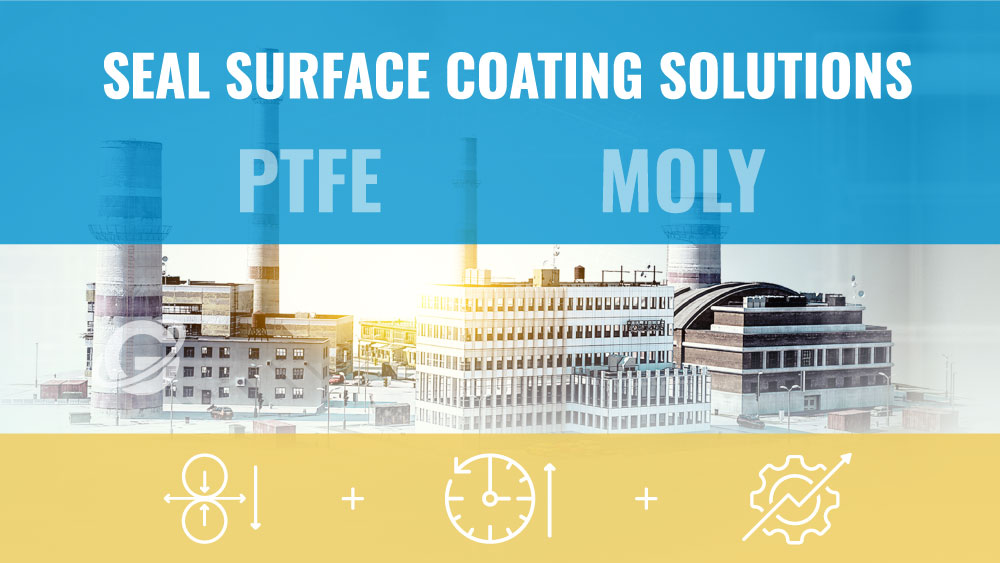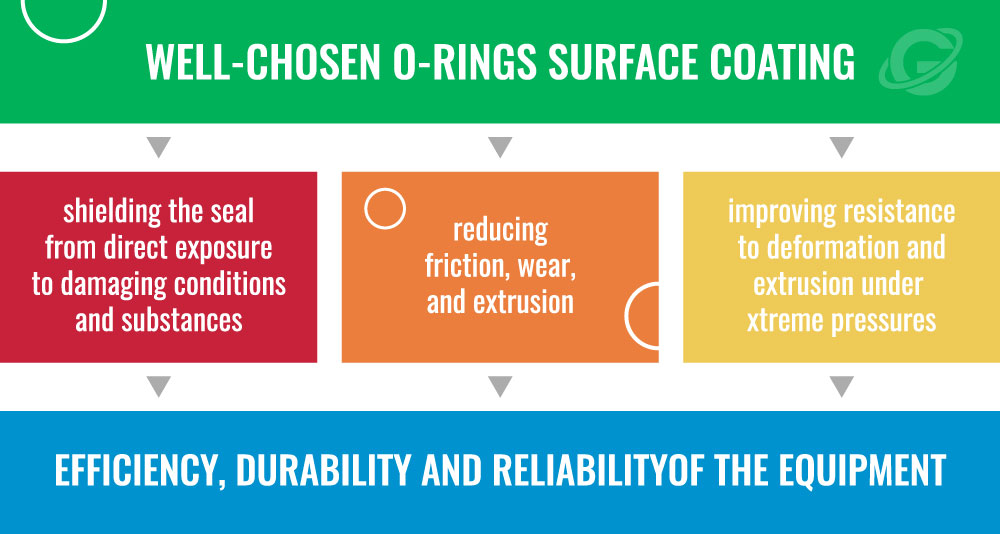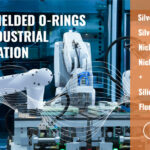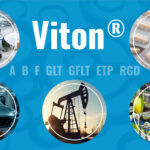
Summary
- Surface coatings like PTFE and Moly significantly enhance o-ring performance by reducing friction, wear, and extrusion, extending their lifespan and operational efficiency in diverse applications.
- PTFE coatings offer unmatched chemical resistance and temperature stability, ideal for harsh and extreme chemical environments, ensuring reliability and performance in critical applications.
- Moly coatings excel in high-pressure and high-stress environments by improving load-bearing capacity and reducing wear, making them suitable for heavy machinery and aerospace applications.
Introduction
The performance of o-rings is critical for ensuring the seamless operation of machinery and the prevention of leaks. These components are fundamental to the integrity of vast systems, yet their efficacy extends beyond the choice of base material or design precision. Surface coatings emerge as a pivotal enhancement to their functionality and lifespan. This blog post explores surface coatings, with a spotlight on Polytetrafluoroethylene (PTFE) and Molybdenum Disulfide (Moly), two substances renowned for their ability to significantly uplift the performance of o-rings across a myriad of industrial applications. By exploring the unique advantages and applications of these coatings, we aim to illuminate the path for selecting the most fitting surface treatment to meet the demanding requirements of modern industry.
The Importance of O-Ring Surface Coatings

The integrity and performance of o-rings are paramount. These seemingly small components play a crucial role in preventing leaks, protecting sensitive parts, and ensuring the smooth operation of various systems. However, the effectiveness of o-rings is not solely dependent on their material composition of design; surface coatings are equally essential in enhancing their functionality and longevity.
Surface coatings on o-rings reduce friction, wear, and extrusion. Friction is a constant challenge in mechanical systems, leading to heat generation, energy loss, and premature wear. A suitable surface coating can significantly reduce the friction between the seal and its mating surface. This reduction not only enhances the operational efficiency of the machinery but also extends the lifespan of the seals themselves.
Moreover, wear and tear on o-rings is inevitable, particularly in applications involving harsh chemicals, extreme temperatures, or high-pressure environments. A well-chosen surface coating acts as a protective barrier, shielding the seal from direct exposure to damaging conditions and substances. This protection minimizes the degradation of the seal material, thereby maintaining its integrity and sealing capabilities over a more extended period.
Extrusion, a significant challenge for o-rings in high-pressure environments, occurs when the seal material deforms and is forced out of the sealing gap, compromising the integrity of the seal. This phenomenon can lead to premature seal failure, resulting in leaks or system breakdowns. Surface coatings enhance the resilience of o-rings by providing an additional barrier that improves their resistance to deformation and extrusion under extreme pressures. By maintaining the structural integrity of the seal, these coatings ensure the reliable and continuous operation of the machinery, protecting against the costly downtime and repair associated with seal failures.
The impact of proper surface treatment on the lifespan and reliability of o-rings is crucial. Surface coatings significantly enhance performance by reducing friction, wear, and extrusion, leading to fewer maintenance requirements and lower operational costs and contributing to the overall reliability of the machinery. Investing in high-quality surface coatings for o-rings is an investment in your equipment’s efficiency, durability, and reliability.
Exploring PTFE Coatings
Renowned for its unique properties, PTFE (Polytetrafluoroethylene) is a fluoropolymer that offers unparalleled resistance to chemicals and extreme temperatures, coupled with an exceptionally low coefficient of friction. These characteristics make PTFE coatings a sought-after solution for enhancing the performance and durability of o-rings across a wide range of applications.
One of the primary benefits of PTFE coatings is their remarkable chemical resistance. PTFE remains inert in the face of almost all industrial chemicals and solvents, making it an ideal choice for seals used in chemical processing, pharmaceuticals, and similar sectors where harsh substances are commonplace. This resistance ensures that the seals maintain their integrity and functionality, even in environments that would degrade lesser materials.
Temperature stability is another hallmark of PTFE coatings. Capable of withstanding temperatures ranging from -200°C (-328°F) to +260°C (+500°F), PTFE-coated seals are ideally suited for applications that experience extreme thermal variations. Whether used in cryogenic conditions or high-heat processes, these coatings maintain their properties, ensuring reliable sealing performance under any circumstances.
The reduced friction characteristic of PTFE coatings is also critical in their effectiveness. PTFE coatings minimize wear and tear by significantly lowering the friction between the seal and its mating surfaces, extending its lifespan. This friction reduction enhances mechanical systems’ efficiency by reducing energy loss, contributing to smoother operations, and decreasing maintenance requirements.
PTFE-coated seals excel in various applications, including aerospace, automotive, food processing, and electronics. Combining chemical resistance, temperature stability, and low friction in these industries is essential for meeting stringent performance and reliability standards.
However, choosing PTFE requires several considerations. The compatibility of PTFE with the seal material, the operating environment, and the specific performance requirements of the application are all critical factors. Additionally, the PTFE coating’s application method can influence the overall effectiveness of the seal, necessitating careful selection of coating processes to ensure optimal adhesion and performance.
PTFE coatings offer a comprehensive solution for enhancing the performance and longevity of o-rings. With their exceptional chemical resistance, temperature stability, and reduced friction, these coatings meet the demands of even the most challenging industrial applications. By carefully considering each application’s specific requirements and conditions, engineers and designers can leverage the benefits of PTFE coatings to achieve superior sealing solutions.
Exploring Moly Coatings
Molybdenum Disulfide, commonly called Moly, is a compound that has carved a niche in industrial applications thanks to its distinctive characteristics. As a solid lubricant, Moly offers exceptional performance under high-pressure conditions, making it an invaluable asset in the design and maintenance of o-rings.
One of the standout features of Moly coatings is their ability to enhance the load-bearing capacity of o-rings, which is particularly important in applications where mechanical components are subjected to extreme stress, as it helps prevent the deformation and failure of o-rings. By forming a protective barrier that can support heavy loads, Moly coatings ensure that o-rings maintain their integrity and continue to perform their essential function of preventing leaks and contamination.
Moreover, Moly coatings are renowned for their ability to reduce wear. This attribute stems from Moly’s low coefficient of friction, which minimizes the frictional heat generated during operation. As a result, o-rings coated with Moly exhibit reduced wear rates, which translates to longer service life and reduced maintenance needs. This wear resistance is particularly beneficial in applications where o-rings are in constant motion or under significant mechanical stress, as it helps preserve the o-ring’s structure and functionality over time.
The applications that benefit most from Moly-coated o-rings involve high-pressure, high-temperature environments or where lubrication is challenging. Industries such as aerospace, automotive, and heavy machinery are prime examples where the durability and reliability of o-rings are crucial for the safe and efficient operation of equipment. Moly-coated o-rings offer a significant advantage in these settings, ensuring that machines can operate smoothly and reliably, even under harsh conditions.
There are several key considerations when determining the implementation of Moly coated o-rings. The compatibility of the Moly coating with the base material of the o-ring is paramount, as this can affect the coating’s adherence and overall performance. The operating environment, including temperature, pressure, and exposure to chemicals, should also be considered, as these conditions can influence the effectiveness of the Moly coating. Additionally, the method of application and the thickness of the layer are critical parameters that can impact the o-ring’s performance and longevity.
In summary, Moly coatings offer a range of advantages for o-rings, from enhancing load-bearing capacity to reducing wear. Their application in industries that demand high performance and reliability from their sealing solutions underscores the value of Moly as a surface coating. By carefully evaluating the specific requirements of their applications, engineers and designers can harness the full potential of Moly coatings to achieve optimal sealing performance.
PTFE vs Moly: Selecting the Right Coating for Your Application

When selecting the most suitable surface coating for o-rings, understanding the comparative strengths and application environments of PTFE and Moly coatings is crucial. Both coatings offer unique advantages that make them preferable under different operational circumstances, and their performance and durability can significantly impact the reliability and efficiency of o-rings in various applications.
PTFE, known for its outstanding chemical resistance and temperature stability, is particularly effective in environments where o-rings gain exposure to harsh chemicals or extreme temperatures. Its low coefficient of friction reduces wear and minimizes the energy losses due to friction, making it an ideal choice for applications requiring smooth operation and longevity. PTFE coatings are well-suited for chemical processing, food and beverage, and pharmaceutical industries, where chemical compatibility and purity are paramount.
On the other hand, Moly coatings are renowned for their exceptional load-bearing capacity and wear reduction. These characteristics are particularly beneficial in high-pressure applications where mechanical stress can lead to premature failure of o-rings. The durability and resistance to deformation offered by Moly coatings make them an excellent choice for heavy machinery, automotive, and aerospace applications, where reliability and performance under stress are critical.
Selecting between PTFE and Moly coatings depends on several operational requirements:
- Chemical Exposure: If the o-rings experience exposure to aggressive chemicals, PTFE’s superior chemical resistance makes it the preferred choice.
- Temperature Range: PTFE’s ability to maintain its properties across a wide temperature range is advantageous for applications involving extreme temperatures.
- Mechanical Load: In applications where o-rings are subjected to high mechanical loads or pressure, Moly’s enhanced load-bearing capacity and wear resistance offer better performance.
- Friction Considerations: When minimizing friction is a priority, PTFE’s lower coefficient of friction can lead to more efficient operation and energy savings.
It’s also important to consider the compatibility of the coating with the o-ring material and the specific conditions of the application environment, including the presence of moisture, the potential for contamination, and the required lifespan of the seal. Consulting with coating and sealing experts can provide valuable insights into the most appropriate choice for a given application, ensuring that the selected coating enhances the performance and reliability of o-rings in their intended operational context.
PTFE and Moly coatings offer distinct advantages catering to different application needs. By carefully assessing the specific requirements of their applications, engineers and maintenance professionals can make informed decisions on the most suitable coating, optimizing the performance and durability of o-rings in any given environment.
Conclusion
The choice of surface coating plays a crucial role in optimizing the performance and longevity of o-rings. The detailed exploration of PTFE and Moly coatings reveals a landscape where each coating has unique strengths tailored to meet specific operational challenges. PTFE stands out for its exceptional chemical resistance and thermal stability, making it the go-to choice for applications demanding purity and resilience against harsh conditions. Meanwhile, Moly excels in environments where mechanical stress and load-bearing are paramount, offering unmatched durability and wear resistance.
One should heavily consider the decision between PTFE and Moly coatings. It requires a thorough assessment of the operational environment, including chemical exposure, temperature extremes, and mechanical loads. This blog post has endeavored to provide a comprehensive overview of the benefits and considerations associated with these coatings, equipping industry professionals with the knowledge to make informed decisions.

 English
English  Español
Español  Français
Français  Português
Português  Deutsch
Deutsch  Italiano
Italiano  Русский
Русский  中文
中文  日本語
日本語  العربية
العربية  हिन्दी
हिन्दी 



